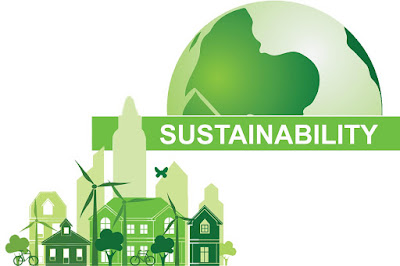In this era of civilisation, every being on this planet is bothered about only one predicament. That is Global Warming. According to Global Footprint Network, majority of the countries has its ecological footprint exceeded the biocapacity with a global per capita ecological footprint of 2.7 global hectares which is 0.9 gha greater than per capita biocapacity. This explains in which direction we are striding. Therefore, there is a great need for the sustainability and environmental friendly construction. Sustainability as said by Brundtland commission is “to meet the present needs by utilising available resources without compromising the ability of future generations to meet their requirements.”
To decrease the impact of anthropogenic activities on this planet, certain methodologies and practises are to be adopted. When it comes to construction industry, it is not anymore exempted from the list of human activities causing global crisis. 32% of landfill waste comes from the construction and demolition of buildings.13% of products delivered to construction sites are sent directly to landfill without being used. All these indications clearly strive for feasible eco-friendly solutions.
Green construction has gained a pace in the past decade with several infrastructure projects built with sustainable design and planning. Efficient use of available renewable sources, reduction of waste, Reuse of waste materials, etc., are some of the cornerstones of the sustainable development. With Green assessment rating systems like LEED (Leadership in Energy and Environmental Design), BREEAM (Building Research Establishment Environmental Assessment Method), etc., Green construction has become more feasible and under inspection.
With growing scientific approaches like Life Cycle Assessment (LCA) Green Construction and Sustainable design will be more efficient in the near future as the present design and rating systems are not scientifically and statistically enriched. Life Cycle Assessment is all about Compilation and evaluation of the inputs, outputs and the potential environmental impacts of a product system throughout its life cycle”. This establishes an environmental profile of the system. Impacts taken into account include (among others) embodied energy, global warming potential, resource use, air pollution, water pollution, and waste.
Also some of the emerging concepts are also striving for sustainable development like Plastic roads (Recently gained pace in Hyderabad, India), energy from waste (1.7-1.9 billion tons of MSW is generated worldwide), Vegeblocks (VegeBlock is composed entirely of recycled aggregates and used vegetable oil), Efficient transportation with use of Real time information (GPS (Global Positioning System)), BIM (Building Information Modelling), Pre casted building elements (Reducing time and ecological footprint), etc.,
Companies like TESLA with its electric cars and solar roof making sustainability more close from envisage to engender. Several other companies like Unilever, IKEA, Panasonic, Allergan, etc., are playing active roles in sustainable development. Also countries striving for sustainable construction and development like India, which has already opened two Green airports, several infrastructure projects is on its way to curb Global warming. To meet the needs of future generations more energy production alternatives are to be implemented like nuclear power while increasing the capacity of present renewable sources like wind, solar, and hydro power. Also, to achieve sustainability in water supply systems, other alternatives like desalination are to be adopted to save this world from water crisis.
To decrease the impact of anthropogenic activities on this planet, certain methodologies and practises are to be adopted. When it comes to construction industry, it is not anymore exempted from the list of human activities causing global crisis. 32% of landfill waste comes from the construction and demolition of buildings.13% of products delivered to construction sites are sent directly to landfill without being used. All these indications clearly strive for feasible eco-friendly solutions.
 |
| illustration: CS |
Green construction has gained a pace in the past decade with several infrastructure projects built with sustainable design and planning. Efficient use of available renewable sources, reduction of waste, Reuse of waste materials, etc., are some of the cornerstones of the sustainable development. With Green assessment rating systems like LEED (Leadership in Energy and Environmental Design), BREEAM (Building Research Establishment Environmental Assessment Method), etc., Green construction has become more feasible and under inspection.
With growing scientific approaches like Life Cycle Assessment (LCA) Green Construction and Sustainable design will be more efficient in the near future as the present design and rating systems are not scientifically and statistically enriched. Life Cycle Assessment is all about Compilation and evaluation of the inputs, outputs and the potential environmental impacts of a product system throughout its life cycle”. This establishes an environmental profile of the system. Impacts taken into account include (among others) embodied energy, global warming potential, resource use, air pollution, water pollution, and waste.
Also some of the emerging concepts are also striving for sustainable development like Plastic roads (Recently gained pace in Hyderabad, India), energy from waste (1.7-1.9 billion tons of MSW is generated worldwide), Vegeblocks (VegeBlock is composed entirely of recycled aggregates and used vegetable oil), Efficient transportation with use of Real time information (GPS (Global Positioning System)), BIM (Building Information Modelling), Pre casted building elements (Reducing time and ecological footprint), etc.,
Companies like TESLA with its electric cars and solar roof making sustainability more close from envisage to engender. Several other companies like Unilever, IKEA, Panasonic, Allergan, etc., are playing active roles in sustainable development. Also countries striving for sustainable construction and development like India, which has already opened two Green airports, several infrastructure projects is on its way to curb Global warming. To meet the needs of future generations more energy production alternatives are to be implemented like nuclear power while increasing the capacity of present renewable sources like wind, solar, and hydro power. Also, to achieve sustainability in water supply systems, other alternatives like desalination are to be adopted to save this world from water crisis.